One of the strangest teams this season in terms of outperforming analytics is the Championship’s Swansea City. Without looking at their league position, one would think that the Welsh team were just above mid-table or perhaps just a small bit higher. In reality, they are second, four points off first-placed Norwich.
Steve Cooper’s men were quite a surprise in the playoffs last season and only qualified on the last day of the campaign due to Nottingham Forest’s utter capitulation at the hands of Stoke City, which dropped them out and allowed Swansea to take over.
Ultimately, Swansea lost in the semi-finals to a superior Brentford, but this season, they have come back even better and are in a stronger position to get promoted, despite what the statistics show.
Their goalscoring statistics are respectable but not overly staggering, scoring 33 goals in 26 games as of writing. However, what has really helped them gain their high placement in the league table is their defensive record, which is the best in the division. The Swans have only conceded 15 goals in their 26 games this season, an astonishing record.
In this tactical analysis article, which will be written in the form of a scout report, we will take a look at how and why Swansea are performing so well this season by performing an analysis on Steve Cooper’s tactics.
Formation and starting XI
Cooper usually deploys a back three formation with three midfielders. Recently, since signing Conor Hourihane on loan, their starting system has been a 3-5-2 with a single-pivot in midfield, but they have used a 3-4-1-2 throughout the campaign also, generally with Yan Dhanda or Korey Smith as a number 10.
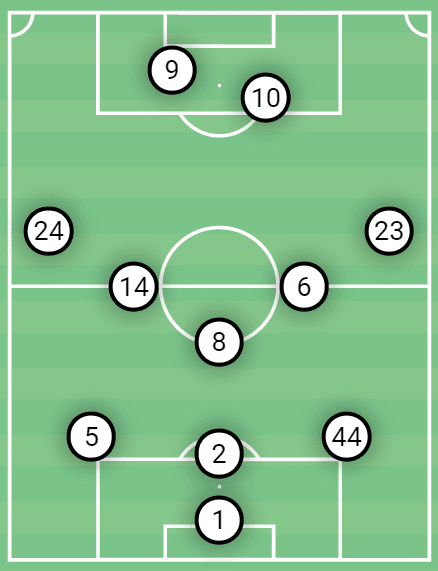
Freddie Woodman is Swansea’s first-choice goalkeeper, and he plays behind a back three consisting of Marc Guehi, Ryan Bennett, and Kyle Naughton, although Ben Cabango and Joel Latibeaudiere are rotated in-and-out at times.
Cooper opts to use Matt Grimes as a number single pivot in the 3-5-2 system, usually supported by Hourihane/Smith and Jay Fulton/Dhanda, with Jake Bidwell and Connor Roberts flanking the midfield.
His preferred strike partnership this season has been Andre Ayew and Jamal Lowe, a very dynamic and technical duo.
Patient build-up play
Their shape in possession is typically a 3-1-4-2 or a close variation of that structure. Of course, this means that when they are in the positional attack phase, they use a 3-1 structure against the opponent’s first line of pressure with their three centre-backs and holding midfielder, usually Grimes.
The three central defenders push wide to cover the width of the pitch – whilst the wingbacks venture forward in their shape – in order to cover the channels but to also stretch the opposition’s press.
The single pivot player sits in behind the opponent’s first line of pressure – almost always a two-man press from the front. This pivot player will drop to the ball-side depending on which defender has possession.
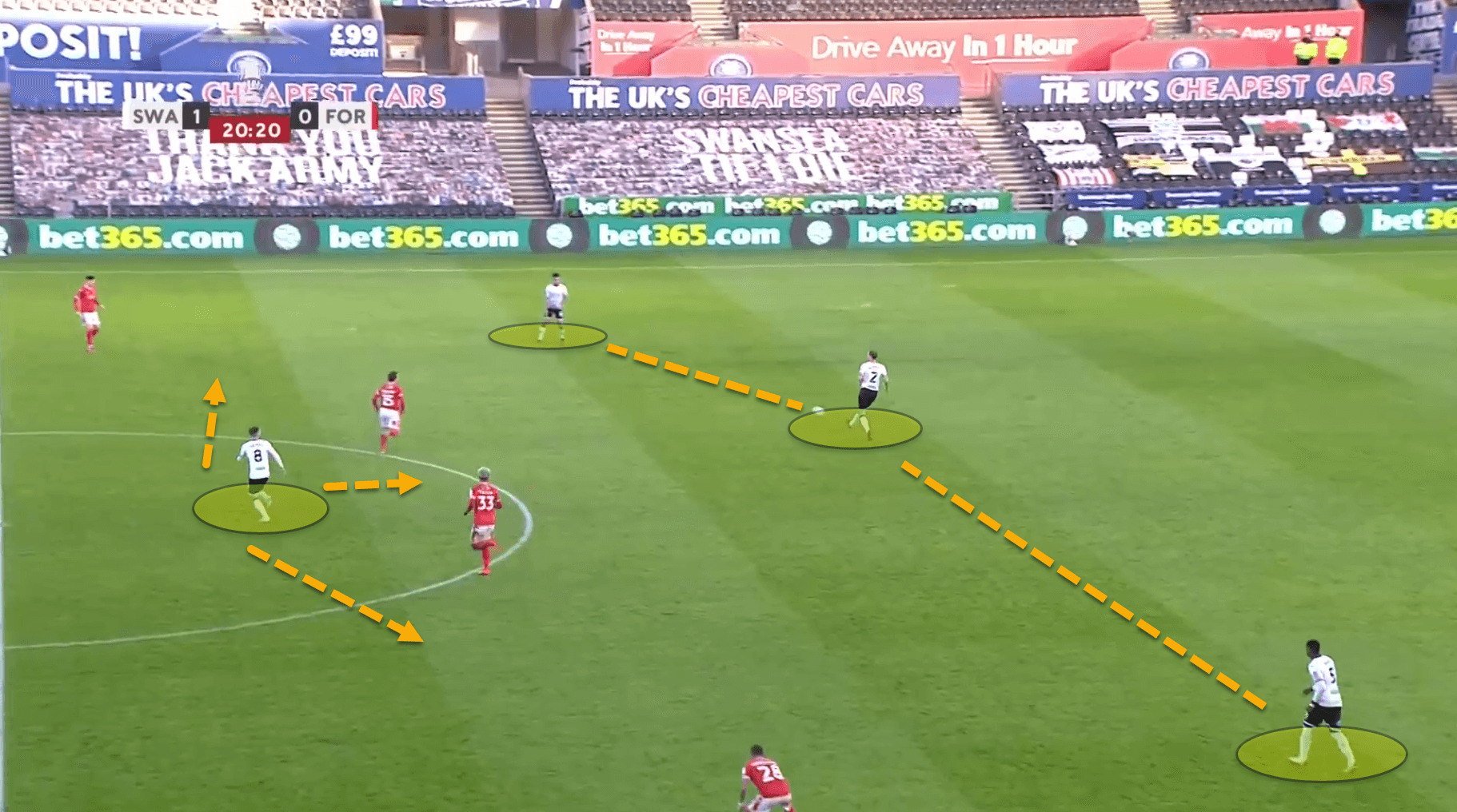
Their usual 3-1 build-up structure can be seen in the image above. Grimes is positioned behind Nottingham Forest’s first line of pressure when the central centre-back has the ball but moves to drop to the side when the ball is played out to the wide defender.
At times though, this can be rather easy to defend against by placing one of the centre-forwards on the pivot player, and so Cooper instructs his advanced midfielders to move into the space alongside Grimes to give the backline more options to play through the opponent.
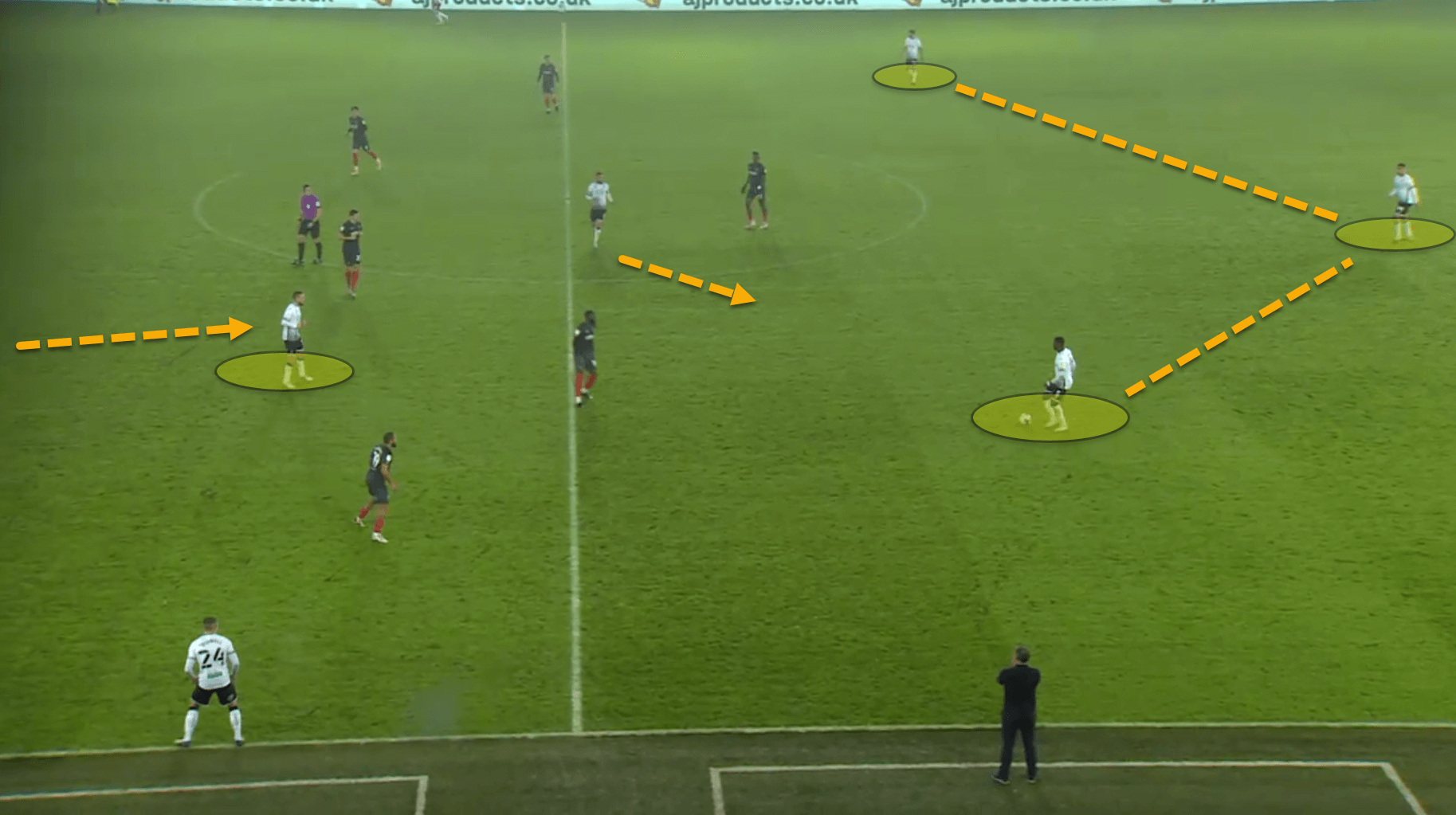
Here, we can see this movement occurring. Brentford are very compact between the forward line and midfield and so progression to the pivot player is quite difficult so Hourihane drops into this area to give the backline another progressive passing option to try and get Swansea further up the pitch.
Combination play out wide
However, despite having a solid central structure in possession, Swansea predominantly like to play out wide, particularly by combination play with the wingbacks, advanced central midfielders, and the ball-near centre-forward.
As seen in the above images, the 3-1 structure with the pivot and backline does not offer much chance for central progression, but the reason Cooper deploys this is because his main focus is building through the wide areas where Swansea are strongest.
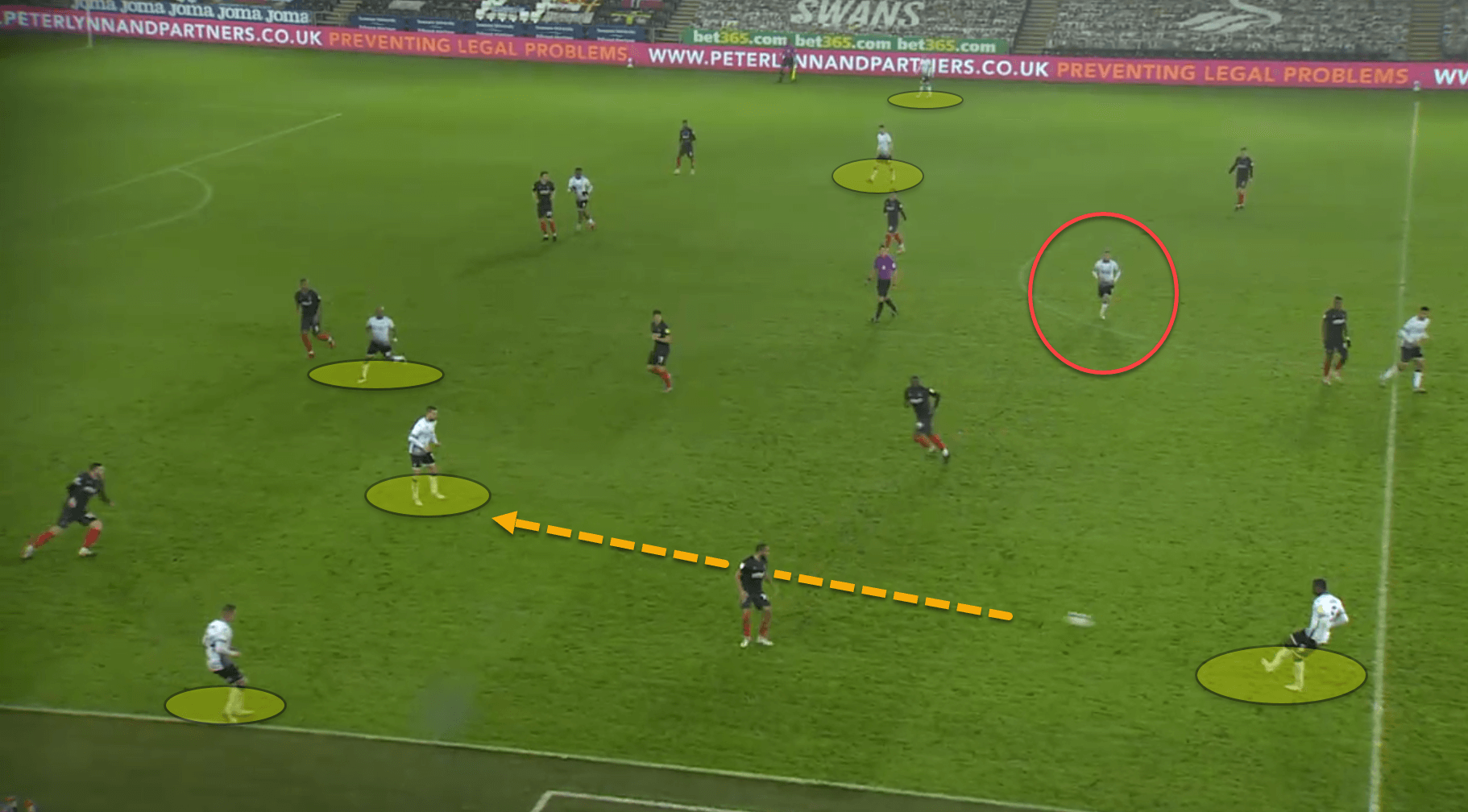
Here, we can see their offensive structure when they move further up the pitch. From this set-up, it is very clear to see Cooper’s emphasis on maximising width when his team are in possession and playing in the wide areas.
When trying to break down the opposition further up the pitch, the ball-near advanced midfielder positions himself in the halfspace with the wingback, of course, positioned in the wide channel. The ball-near centre-forward sets himself in the channel between the fullback and centre-back, prepared to run in behind the fullback when the opportunity arises.
The closest centre-back also pushes up to get involved with the play but to also be in close proximity to push up and help the surrounding players to counterpress and win back possession when they lose it.
On the far side of the pitch, you can also see this set-up in case Swansea are unable to play down the ball-side and need to switch the play or else recycle possession and work their way over.
The objective is to create combination play with the centre-forward, wingback, and midfielder to break the opponent’s defensive line and get in behind the backline.
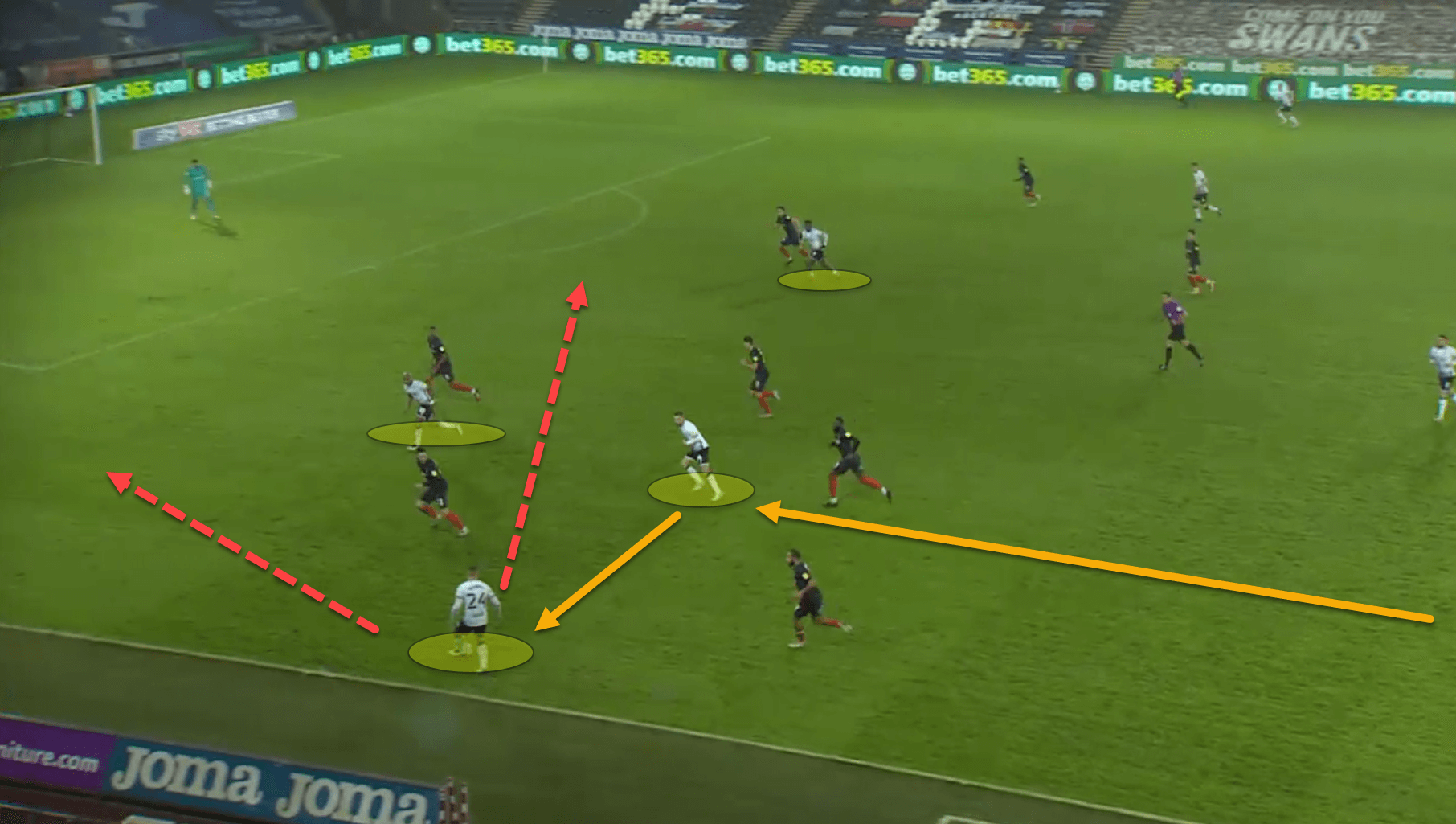
This exact passage of play can be seen to work successfully here. The positioning of the centre-forward in between the opposition’s fullback and centre-back is crucial to these attacks because it pins back the fullback.
As can be seen in the latest image, the Brentford fullback is unable to go to Bidwell as it means that Ayew has a free run on his blindside. It also drags the opposition’s centre-back to follow the run, stretching the backline and leaving gaps to play through.
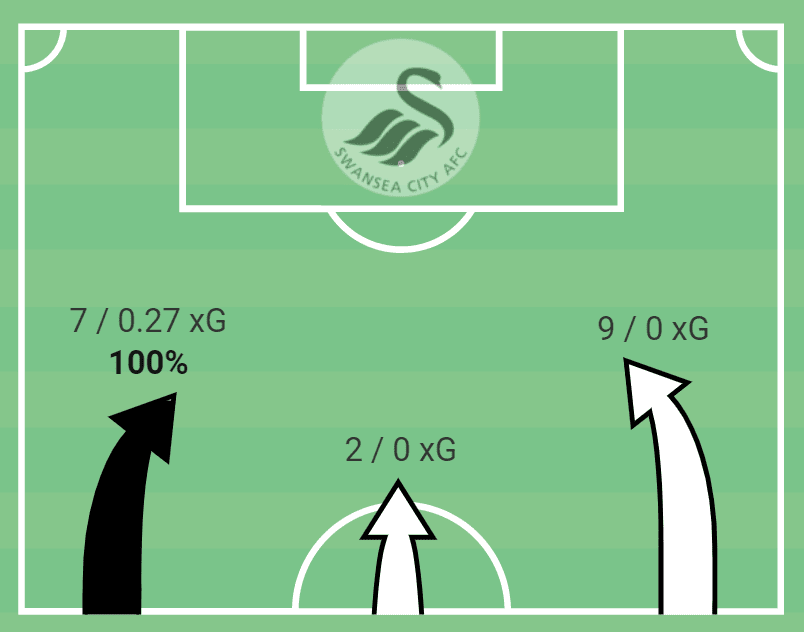
As we can see from this visual representation from one of Swansea’s recent games against Brentford, 16 of their 18 positional attacks were down the flanks, a constant pattern in every game.
From these areas, they look to play the ball into the box from crosses or else play directly through on goal. This season, Swansea are the sixth-highest ranked team in the Championship in terms of key passes, averaging 2.68 per 90, as well as 4.8 smart passes, mainly from areas and passages of play as such.
They also average 13.49 crosses per game with a high accuracy rate of 33.4 percent.
Allowing play out wide
As we have already stated, Swansea have conceded merely 15 goals in the league this season, an average of just 0.54 per 90, the best defensive record in the division. They are massively overperforming their expected goals against (xGA) of 25.56, over 10 goals more than they have actually conceded.
The reason they have conceded so few goals is simply because of how well-drilled they are in their defensive structure. Deploying a 3-5-2 looks like a 5-3-2 when in the defensive phases of play.
Swansea tend not to press too high either. Their Passes Per Defensive Action (PPDA) this season is only the 14th highest ranking in the league at 10.96. When the opposition has the ball in a positional attack, they tend to sit in a 5-2-1-2 mid-block. The aim of this mid-block is to force the opposition out wide and cut off the ball supply into the opponent’s midfield pivot.
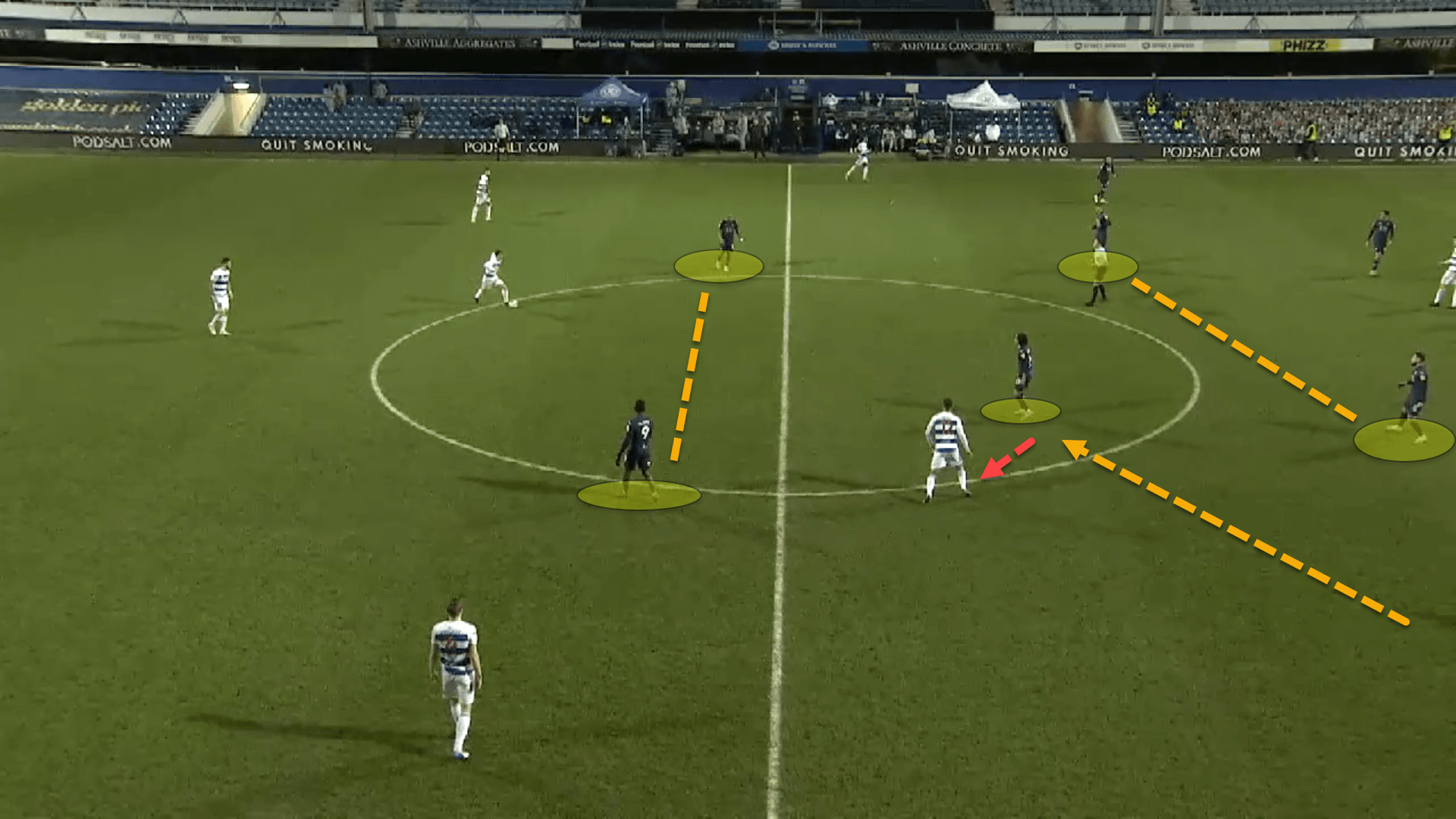
Here is an example of Swansea City in their defensive mid-block. One of the wide central midfielders – in this case, it is Dhanda – pushes up to mark the passing lane into the opponent’s pivot player. By doing so, they cut off the ball supply into the central corridors and the opposition are more likely to play out wide.
The wingbacks remain alongside the three centre-backs but at times when the ball is played out to their opposite number, they go and press if the other side is in Swansea’s half of the pitch. The shape is a 5-2-1-2 in these situations.
If they were up against a double-pivot, the other wide central midfielder would move up to mark the other pivot player and a 5-3-2/5-1-2-2 would be created.
As already touched on, they wanted their opponents to play into the space beside the central midfielders and in front of the wingbacks. When a team deploys a back five system with three in midfield, these wide areas are where the other team may look to play through and exploit.
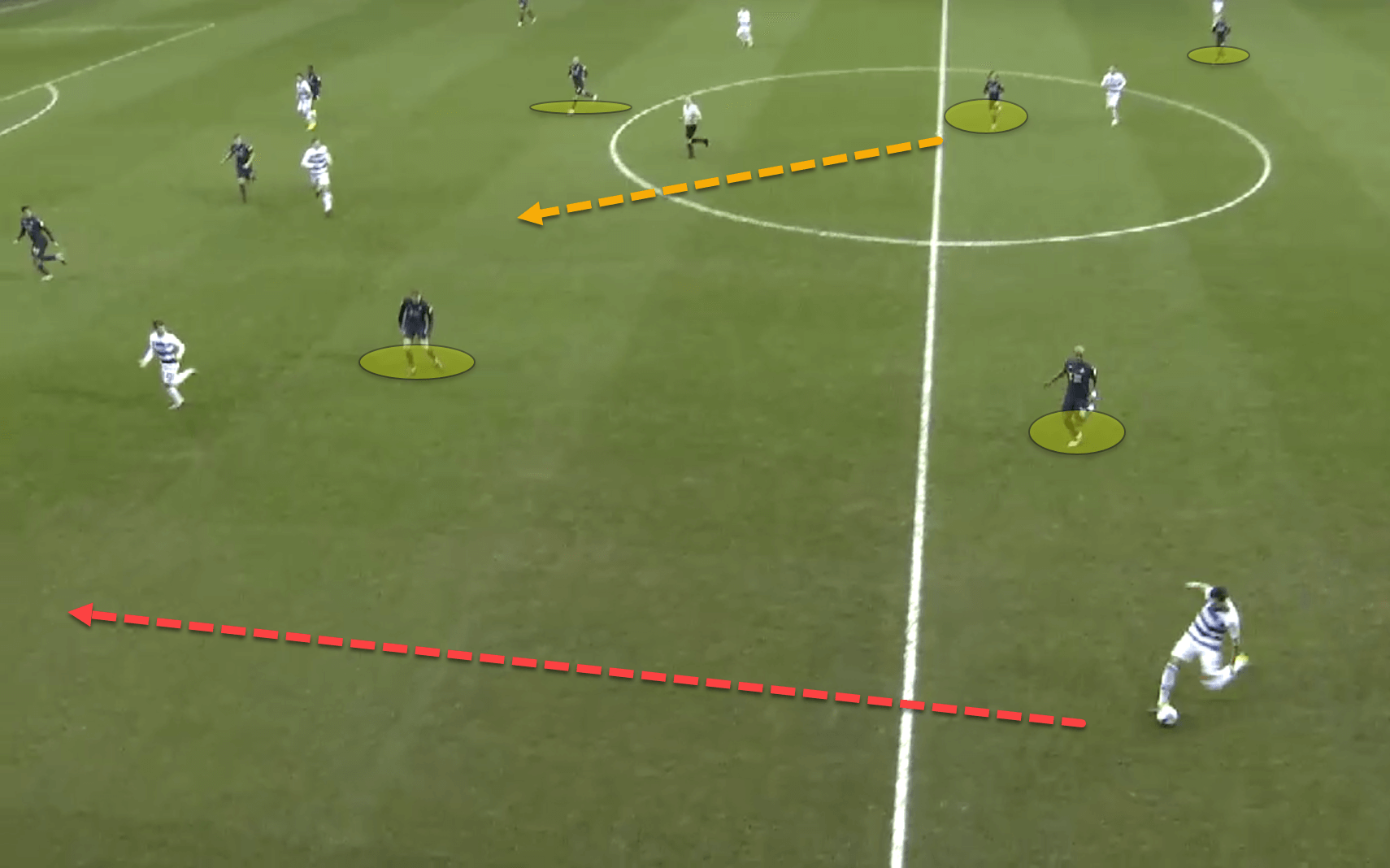
However, Swansea are excellent at stopping crosses into the box and so these areas are generally harmless for them. Only Birmingham City have conceded fewer headed goals this season, and the Swans also have the fourth-highest ranking for aerial duels success this season with 43.9 percent.
Swansea drop into a 5-3-2 low block when the ball is played out to the flanks as they prepare for their opponents to play direct balls into the box.
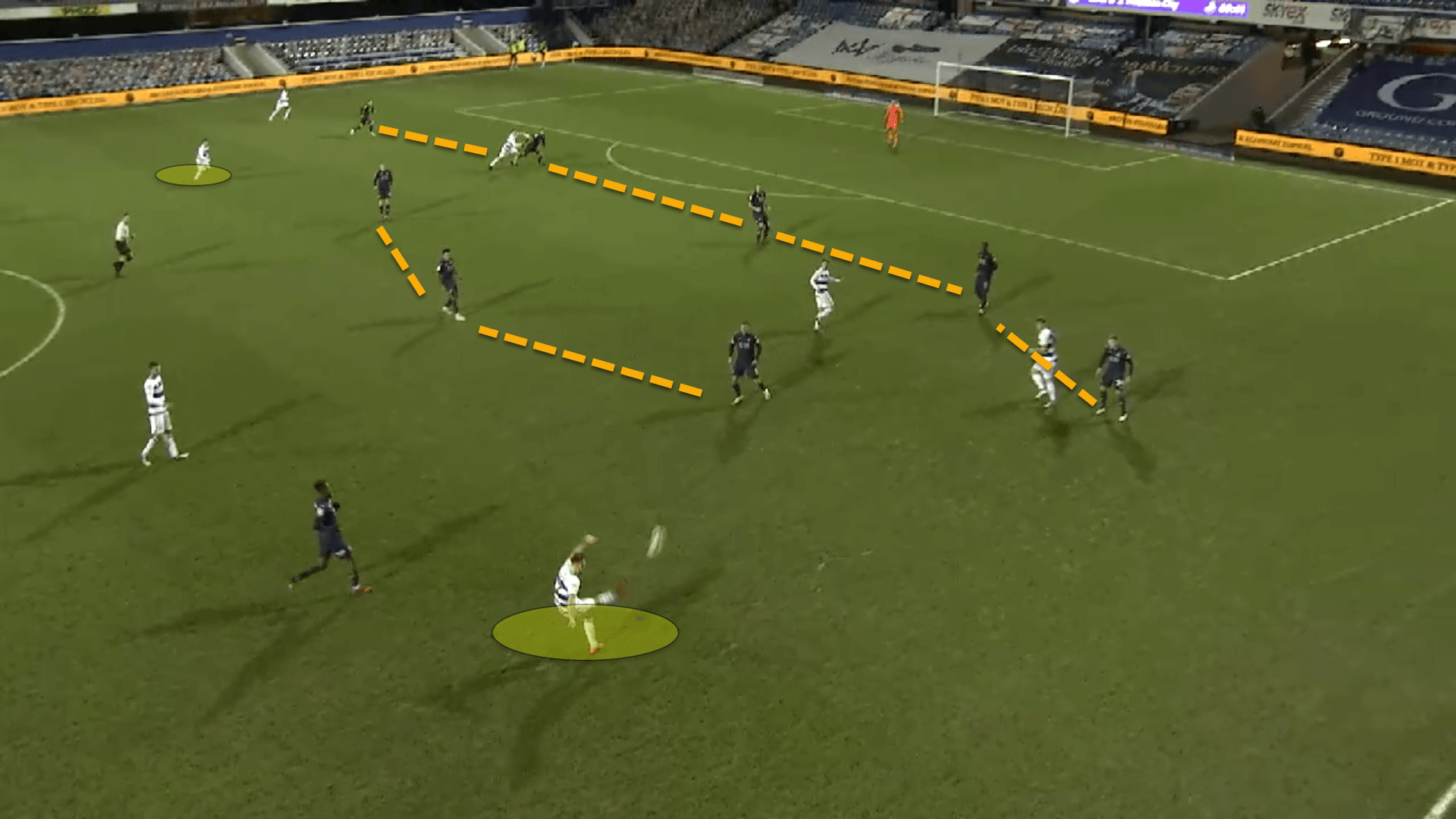
From the image above, we can see their 5-3-2 low block shape, as well as the space that they allow their opposition’s wide players to operate in on the flanks when in possession.
This defensive set-up by Cooper is very effective as it allows his side to control where on the pitch the other team can play into and keeps them at bay in harmless areas where Swansea are comfortable defending.
Finally, it must be noted that Swansea average 63.09 defensive duels per 90 – the seventh-best in the division – winning an extremely impressive 62.8 percent.
Stopping transitions
Finally, and quite briefly, as Swansea do like to have the ball and control the game in the opposition’s half of the pitch with their patient, possession game, they have to deploy a high-line in order to force their opponents deep into the defensive half.
However, to do this, they need to be efficient when transitioning from attack to defence to prevent the opposition from carving them open on the break. Many teams, such as Liverpool and Manchester City, counterpress with numerous players to swarm the ball-carrier and regain possession.
Swansea use a slightly more traditional method. When they lose possession, their first instinct is to drop back into their defensive 5-3-2 shape whilst the nearest player to the ball closes down the ball-carrier in order to delay the transition to allow the other players time to get back as quickly as possible.
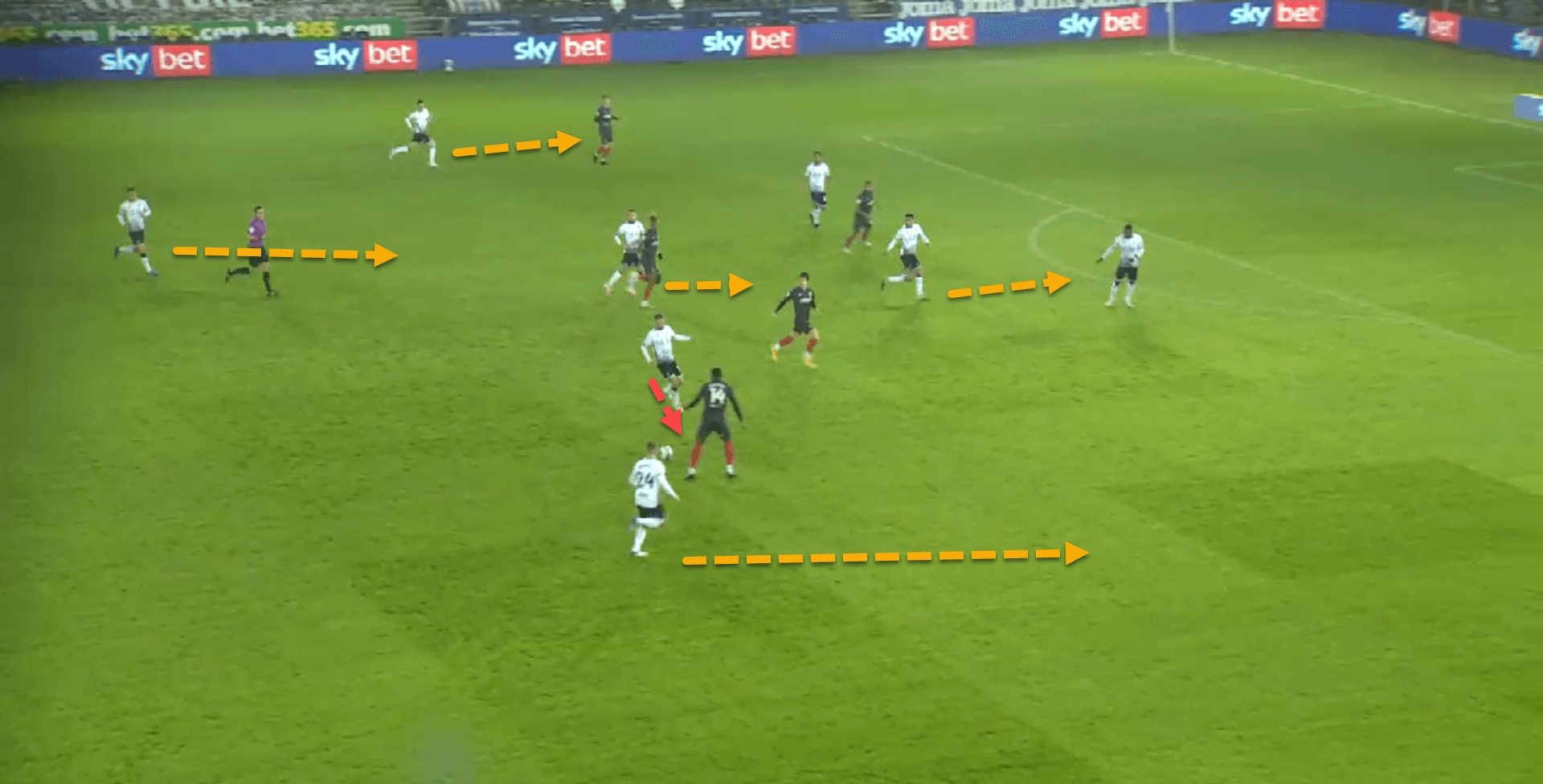
In this instance, Swansea had just lost possession of the ball high up the pitch and Brentford broke at pace. The players got back rapidly to recover their defensive shape and squeezed the pitch in the meantime to give the opposition as little space to play into as possible.
While the surrounding players are reorganising their shape, the nearest player closes down the ball-carrier to delay the attack even further, buying his teammates time to get back.
The Swans have only had 0.55 successful counterattacks per 90 against them in all competitions this season as of writing, which is a fantastic showing of their ability to nullify their opponents when they are transitioning from attack to defence.
Conclusion
Swansea are certainly an interesting team if not peculiar and have undoubtedly been overperforming their expectations and potentially their capabilities all season.
Looking at the expected points table, the Welsh team should only have 39 points this season, rounded up from 38.6. This means that they are overperforming in the league by over 11 points, a huge number. If their expected points total was a reality, the Swans would only be 8th, joint with two other teams also.
If they maintain their performance levels right through to the end of the season, they will be projected to get automatic promotion, potentially bypassing the possibility of a play-off heartbreak for the second season running, and with an upcoming FA Cup fixture to play against Pep Guardiola’s Manchester City, the second half of this season is shaping up to be very exciting for Swansea fans.

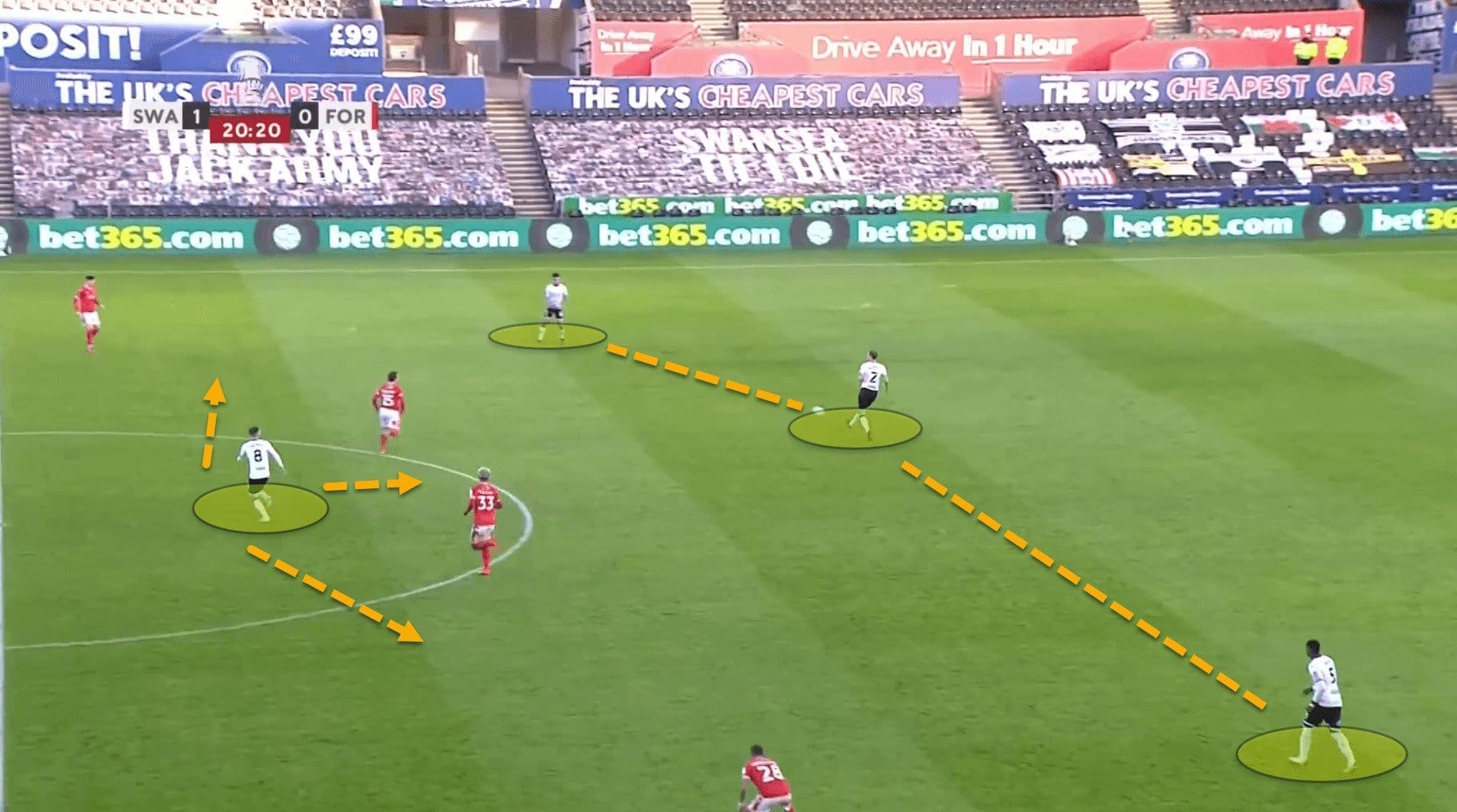



Comments